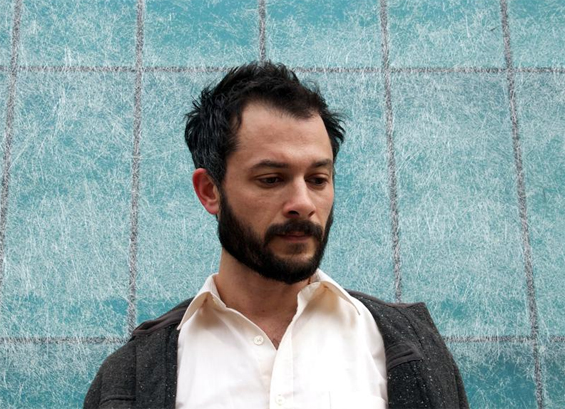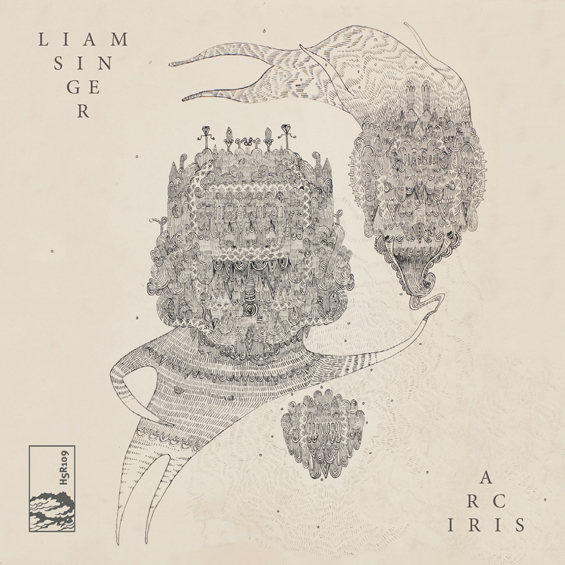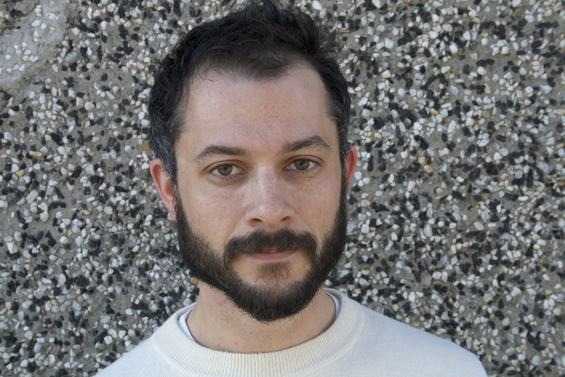

photo: Stephen Somple
BACKTRACKING WITH LIAM SINGER'S ARC IRIS
We've been huge admirers of Liam Singer's work ever since his second album, Our Secret Lies Beneath The Creek (Tell-All Records), crossed our path in 2006. If anything, our appreciation for the Portland-born and New York-based singer-songwriter's gifts only deepened when Hidden Shoal issued his Dislocatia four years later and was once more strengthened upon hearing his latest Arc Iris (reviewed here). In addition to his solo output, Singer contributed piano to the wonderful Balustrade Ensemble album Capsules, occasionally accompanies guitarist Alexander Turnquist live, and is a touring keyboardist with the chamber-electronic ensemble Slow Six. Recently Singer generously agreed to enhance our impression of Arc Iris by sharing with us background details for all fourteen of the album's songs.
1. “Into the Luminous Currents”
I usually feel the need to begin my albums with an instrumental that sets the sonic context. I knew I wanted to start here with something very textural, the piano playing a reduced role, since timbral variety was one of my central concepts for this record. I began with a simple chord progression, then Scott Solter and I chose various landscape imagery to drive our layering of sonic elements, resulting in this beautifully blurred journey into a forest at the bottom of an ocean.
2. “Stranger I Know”
I'm proud of this song and its economy of means. I have a tendency to get crazy chordally, so I'm happy when I find a way to keep things tonally simple and drive a piece along in other ways (in this song, it's the unusual counterpoint and unpredictable rhythms that keep it interesting for me). It could have gone a lot of directions arrangement-wise—when I play it live it's a much more delicate and lullaby-like song—but I like how bringing the drums in fairly late in the game places a more playful vibe against the melancholy vocal and cello lines.
3. “O Endless Storm”
This is the earliest song from the set that's on Arc Iris. I hadn't written anything I liked in a while, and sat down one day to bang out some dumb chords in frustration—then, this music and melody showed up very quickly. I think of the lyrics in this song—and much of Arc Iris—as a sort of allegory for certain emotional states—in this case, a pretty tumultuous one. The chorus describes a recurring dream I had of a woman dressed in wings and armor who always floated backwards as I approached her. The arrangement was very much built in the studio; I had a lot of half-baked ideas that were resulting in a jumbled mess, so Scott and I stepped back and figured out how to assign sounds in a more pointillistic fashion. I love how it turned out sonically, especially the blending of Wendy Allen's vocals and the flutes in the chorus.
4. “The Dance of Cupid and Psyche”
I have a habit of churning out unabashedly Morroconi-inspired little pieces, and when they're catchy enough to root themselves in my head they'll find their way onto my albums. I think the cello melody came out beautifully here. Scott and I often spoke generally about adding ambient “ghosts” and trails on this record, which you can hear a lot of in this song with a close listen.

5. “Dear Sister / Gears Turn in Gears”
This turned out to be one of the more cinematic songs on Arc Iris. I have a friend who likes to invoke Danny Elfman when talking about my music, and though I can't see it generally I definitely do on the second half of this piece. Like many songs on this record, it describes a person who's caught between two worlds.
6. “Nine Ten”
It's difficult to imagine, but I originally wrote this piano line to accompany a surreal/absurdist cover that I dreamed up of an Iggy Pop song. Once I decided that was a stupid concept, I still had a melody I liked, so I started writing some ideas against it and came up with “Nine Ten.” I like how each timbral element occupies its own space here. I wanted the percussive pulse to mimic the sound of a muffled dance party, though it is actually an acoustic drum being played. We fed my vocals through some crumpled up tape loops to get the papery effect you hear. I think the Kora set against the piano sounds really beautiful and, as always, Wendy Allen rules.
7. “The Astronaut”
Some songs happen all at once and some are a combination of ideas. This one brings together melodic fragments I'd written over an extended period that never really found a home, or were part of discarded pieces. In fact, the instrumental melody that appears throughout the song is from one of the first things I ever recorded on my four-track in high school. I'd been meaning to give it a second chance for a while; it just ended up taking sixteen years! Scott and I invented a sort of fake glass harmonica that appears on a few of Arc Iris's tracks, which is what gives some sections here their luminous quality.
8. “Plestiodon Fasciatus”
I dig this little melody; its shape was inspired a bit by Aphex Twin's piano pieces, and the use of the snare drum by the driving feeling in Arnold Dreyblatt's work. The Plestiodon Fasciatus is the name of a type of blue lizard that I was visited by twice last year, once while camping in Zion national park and once while in North Carolina mixing this record.
9. “Disappear and Appear”
Definitely the most over-the-top thing I've recorded—sometimes I really love it and sometimes I'm almost embarrassed by its high drama. But as the song started to take shape, it got bigger and bigger conceptually. I wrote the single-line chorus melody in my head on the subway after seeing a performance of Stravinsky's The Rite of Spring, and the song emerged from there. The unison breakdown in the middle was inspired by a musical project I never quite got off the ground called MVIMPVM, which involved a group of musicians playing songs that often delved into absurd yet tightly rehearsed and controlled melodic tangents. Theo Metz plays percussion throughout the record, but this is the song where his personal style really gets to shine through.

10. “Forever Blossoming”
This track is another dramatic one in its own way, in the sense that it's my version of a “ballad.” It's got some of my favourite lyrics on the whole record. I wrote it shortly after watching the Leonard Cohen doc Bird on a Wire, so guess I was feeling self-indulgent enough to take some lyrical risks.
11. “I Was Glad to Hear From You And I Liked the Way You Signed Your Name”
Another central theme in my conception of this album was “controlled insanity.” I was less concerned with whether ideas were good or bad and more with allowing my crazier instincts to surface and pursuing them. Hence, a song like this with its ridiculous melody—not sure where it came from, but I'm glad I made it. The title is a quote from a letter I received from Mr. Rogers after writing to him at age five.
12. “Unhand Me (You Horrid Thing)”
People really seem to connect with this song, so I don't actually want to say too much about the lyrics and what they mean to me personally. I'm also told I should write more songs like it, which, listen guys, I would if I could.
13. “Coma Nocturne”
One day I'd like to make a whole record of pieces like this. Scott and I spent a good while improvising and adding little sonic details and treats, which gives the song a haunted, twilight sheen that I love.
14. “Eye Eclipse Eye”
The tape fragment that comprises this piece is taken from the intro track, so it's a bit of a return to the beginning, albeit stripped down and deteriorated.
August-September 2013![]()